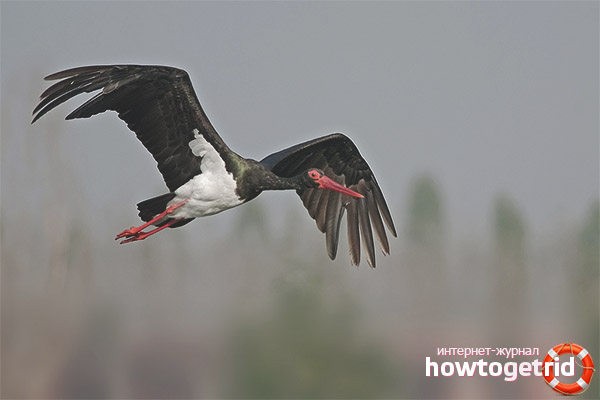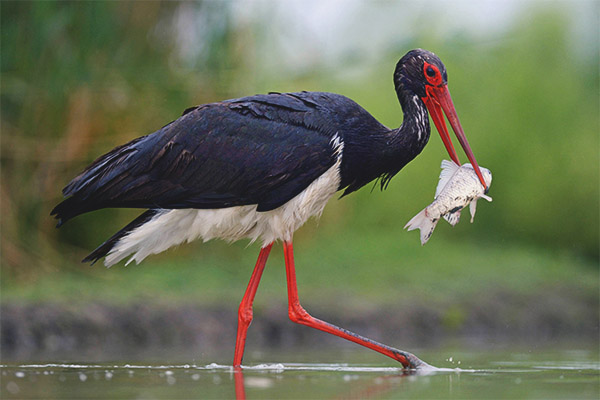The content of the article
Storks - stately proud birds, living for a long time near people. The family of stork has 18 species and is divided into 9 genera, they live in all parts of the Earth, except for deserts. It's about a black and white stork.
Description
Black and white stork is listed in the Red Book. The body length is 105-110 cm, wingspan - 215-220 cm, weight - up to 3.5 kg. The tail length is moderate, the end is slightly rounded. The black-and-white stork is covered with black feathers with a violet-green, reddish or metallic tint, has a white chest and belly. From the side it looks like a tailcoat, wearing a white shirt. Legs and places not covered with feathers are red. The bill is long, 2 times longer than the head, with a sharp end. It has a dark color, only in chicks and adults at the time of mating games becomes red.
Environment and habitat
Storks live practically all over the world, in every corner of the Earth, except for deserts.In Russia, black and white storks live in all areas, most often settling in Primorye, in the Far East, in the areas of Kaliningrad and Ciscaucasia. There are many swampy forests in Belarus that are ideal for living in all respects, there are especially many storks. The government even decided to protect the territory most densely populated by storks. Also, these birds are found in large numbers in China, Poland, the lands of Italy, in East and West Germany.
The black stork is rather shy and very cautious, prefers to settle as far as possible from people and animals, choosing deaf forest corners, closer to swamps, lakes and ponds. Nests are arranged on the tops of trees at a height of 10-15 meters, branches are used as a building material, and they are laid in the right way, and clay and turf are used for fastening. The diameter of such dwellings can be up to one and a half meters, and the weight can reach half a ton. They live for many years, often the nests pass by inheritance to children who also live in them every year, acquiring offspring.
Wintering
Black storks are migratory birds, especially those who chose moderately warm zones to live in.winter fly away to warm lands. Embark on a journey in late August - early September, keeping all the way closer to the water. For wintering choose the African continent or India. Although black storks lead an isolated lifestyle, avoiding other birds, but often they set off on a long journey with storks of other species. Wide wings make 2-3 strokes per second. This allows you to move with considerable speed - up to 40 kilometers per hour. For planning, they use upstream - it allows you to stay in the air for a long time, without getting tired and give your wings rest. Such devices help to overcome up to 200 kilometers per day.
Birds get to wintering grounds by early December and evenly populate the entire territory, where they live until the beginning of spring, when it is time to go home. Returning, storks fly to their nests, bring order to them, repair. Birds have a strong attachment to their home.
The enemies

The black stork has no enemies in nature. The only one who can sometimes attack is the eagles. Sometimes crocodiles. But this rarely happens. The main enemy is man.Thus, in Italy at the end of the 17th century, storks were completely exterminated.
Nutrition
Storks prefer food of animal origin, although they do not differ in food choices. They feed mainly on fish and animals living in the water. But during the overflights and drying up of water bodies in extreme heat, when there are few fish and amphibians, we have to eat other food. For example:
- Small mammals - mice, rats, ermines, rodents.
- Amphibious - frogs, different types of lizards, toads.
- Insects - locusts, grasshoppers, Medvedok, May beetles. The larvae of these pests are also eaten.
- Nestlings of wild birds, in the villages and villages they catch domesticated ones - chickens, ducklings.
Deforestation, as well as the drying of meadows and swamps causes great harm to storks, because the food supply is destroyed.
Some interesting things about black storks
- In China, it was believed from ancient times that the stork means happy carefree old age.
- Many nations in Europe consider the stork as a symbol of care for elderly parents, because adult birds do not allow aged people, who are unable to get food for their relatives, to feed them with hunger.
- The legend that where a stork lives, there will always be a good harvest, spread everywhere.Therefore, storks are very revered in villages and villages, residents reinforce the wheels on their roofs from old carts so that the stork builds a nest in them. If the feathered tenant suddenly flew away from this place, then it was considered a punishment for sinful life, waiting for the collapse of various misfortunes, troubles and misfortunes on the tenants of this house.
- If the couple flies back and begins to live in the nest again, then a child will appear in the family occupying the house. It is possible, from this belief, and went the sign that the stork brings children.
- Storks have been living in nature for a little more than twenty years, while in captivity - a little longer. There are cases when storks lived to be 31 years old.
- Sometimes storks carry out some kind of stripping in their ranks, getting rid of weak and sick relatives - they are killed. Most often this is done before the flights. Maybe there is a reason for such cruelty: weak individuals will not be able to reach the right place, while they will be a brake on the pack, delaying it.
- In addition to the beauty and grace of these birds differ in the assistance provided to man in agriculture - they, in search of food, destroy plant pests.
- Black storks are good environmental indicators.Having seen that the bird of this species feeds on the reservoir, one can be sure that the water is clear of pollution and chemicals.
- The female lays from three to five eggs. In the incubation of the clutch, both parents take part, the incubation of eggs continues from 32 to 38 days. If it becomes hot in the nest, the birds begin to spray the eggs with water so that they cool. Both parents also take part in feeding - they belch the food, and the chicks pick it up from the bottom. At two months, children begin to learn to fly, and at the age of three months, they begin an independent life.
- The structure of the vocal apparatus of storks is such that they are not able to make sounds, only they know how to squeak softly. Therefore, they communicate with each other with hissing and clicking beak.
- The language of white and black storks is different, so they can not understand each other, although they are representatives of the same species. Italian scientists have attempted to cross these two subspecies - the attempt was unsuccessful.
- If the male is free, then the first female who has flown to the cry becomes his wife.
- The Belarusians made the stork one of the symbols of their country. In one of the tales of local folklore tells about the appearance of these birds.God handed the man a large bag full of snakes and ordered to throw him away into the sea. But curiosity filled the man, he untied the bag and began to look into it. Snakes climbed out to freedom and spread to all corners of the earth, God punished man by turning him into a stork. Now the unfortunate wanders from the swamp to the swamp, exterminating snakes and, until he catches the last one, he cannot become a man back.
Video: Black Stork (Ciconia nigra)











To send